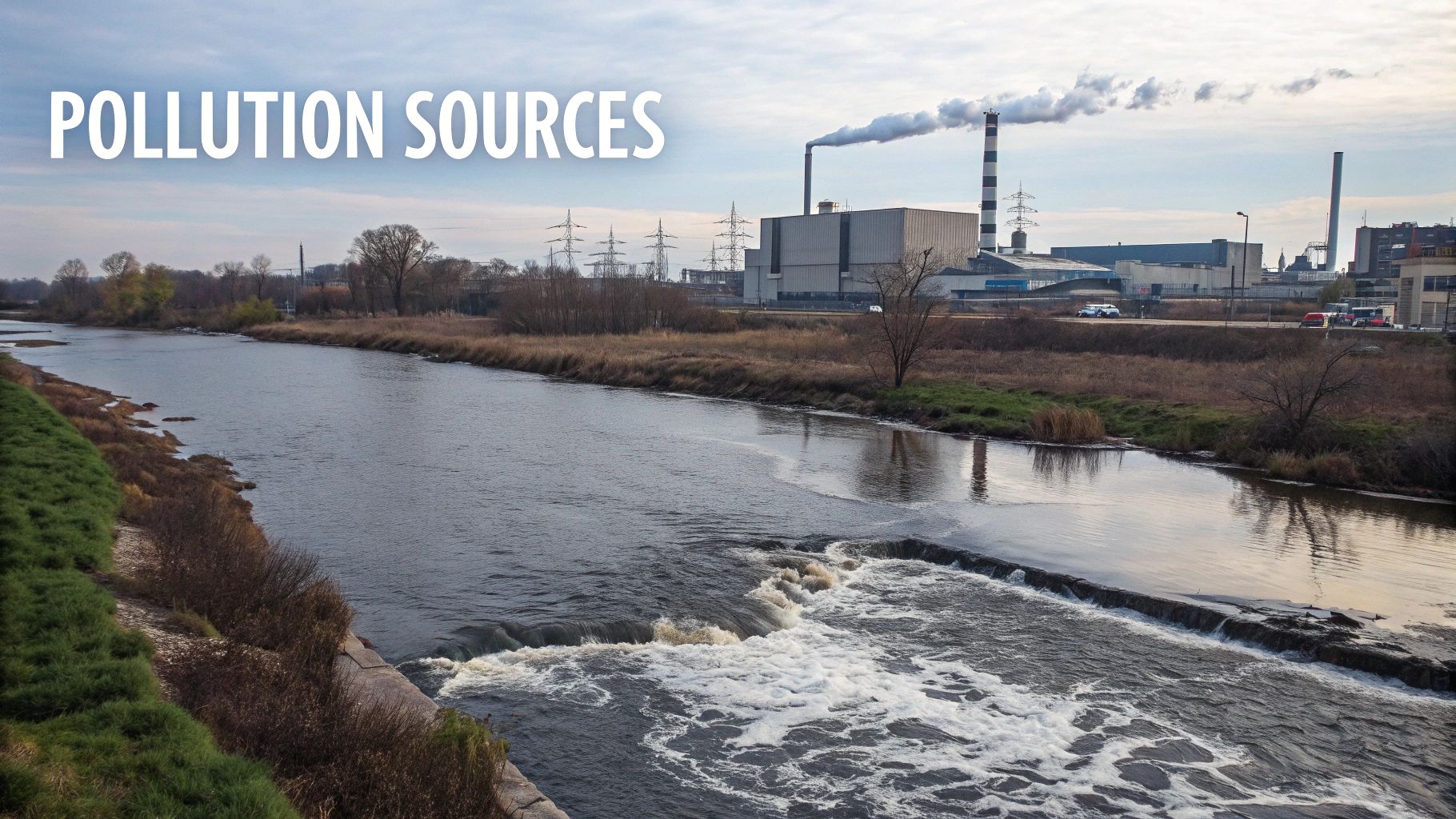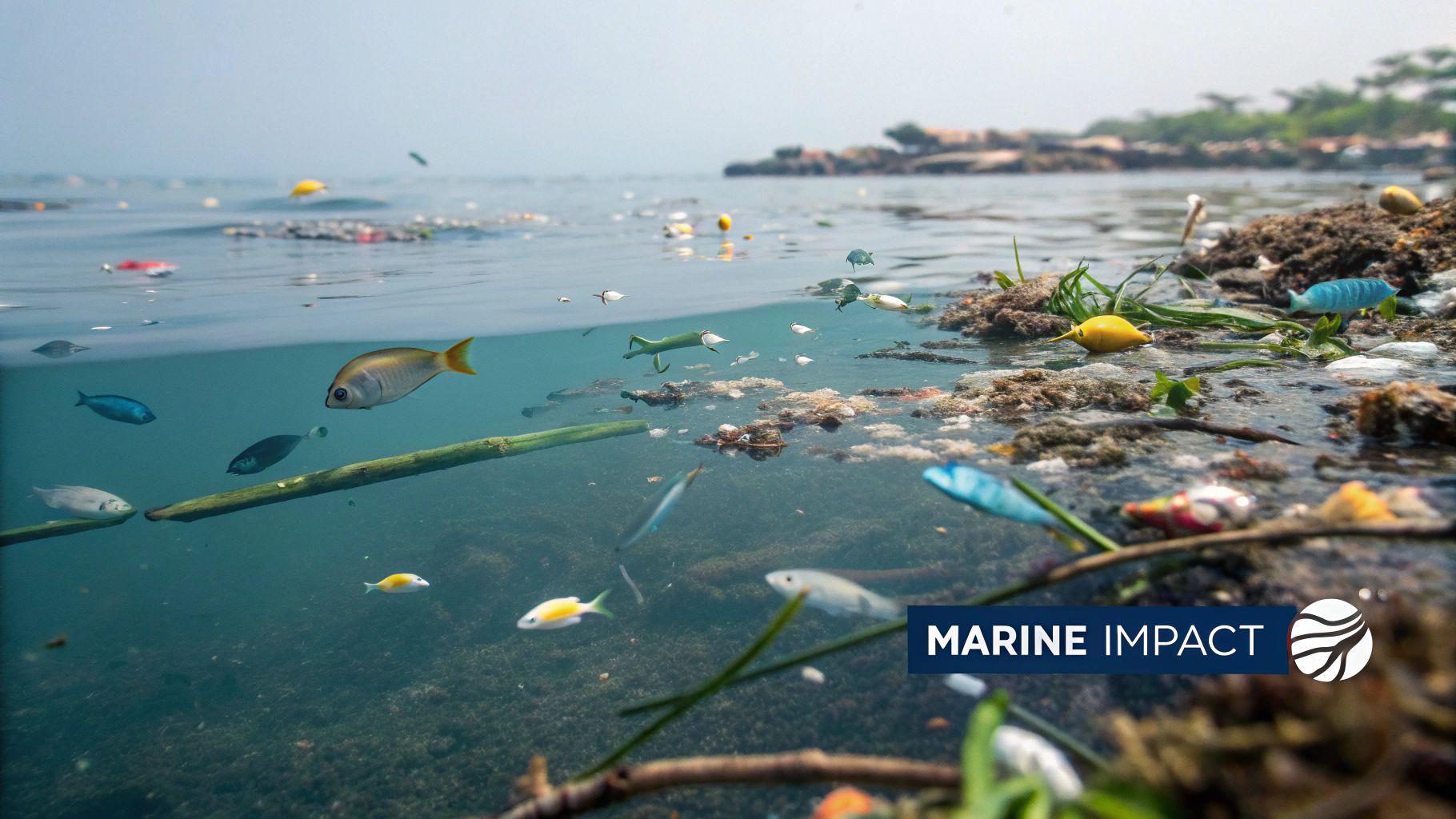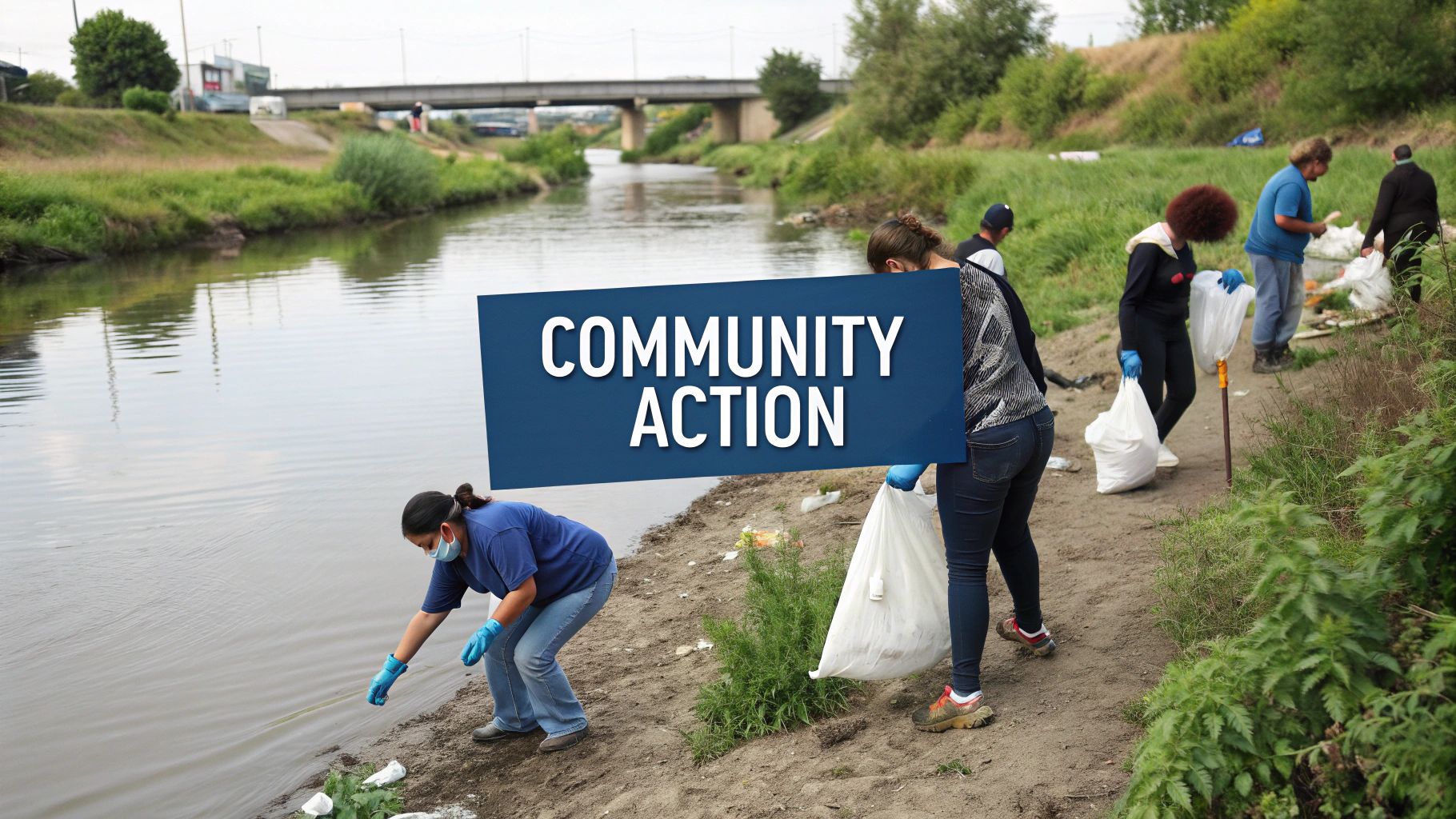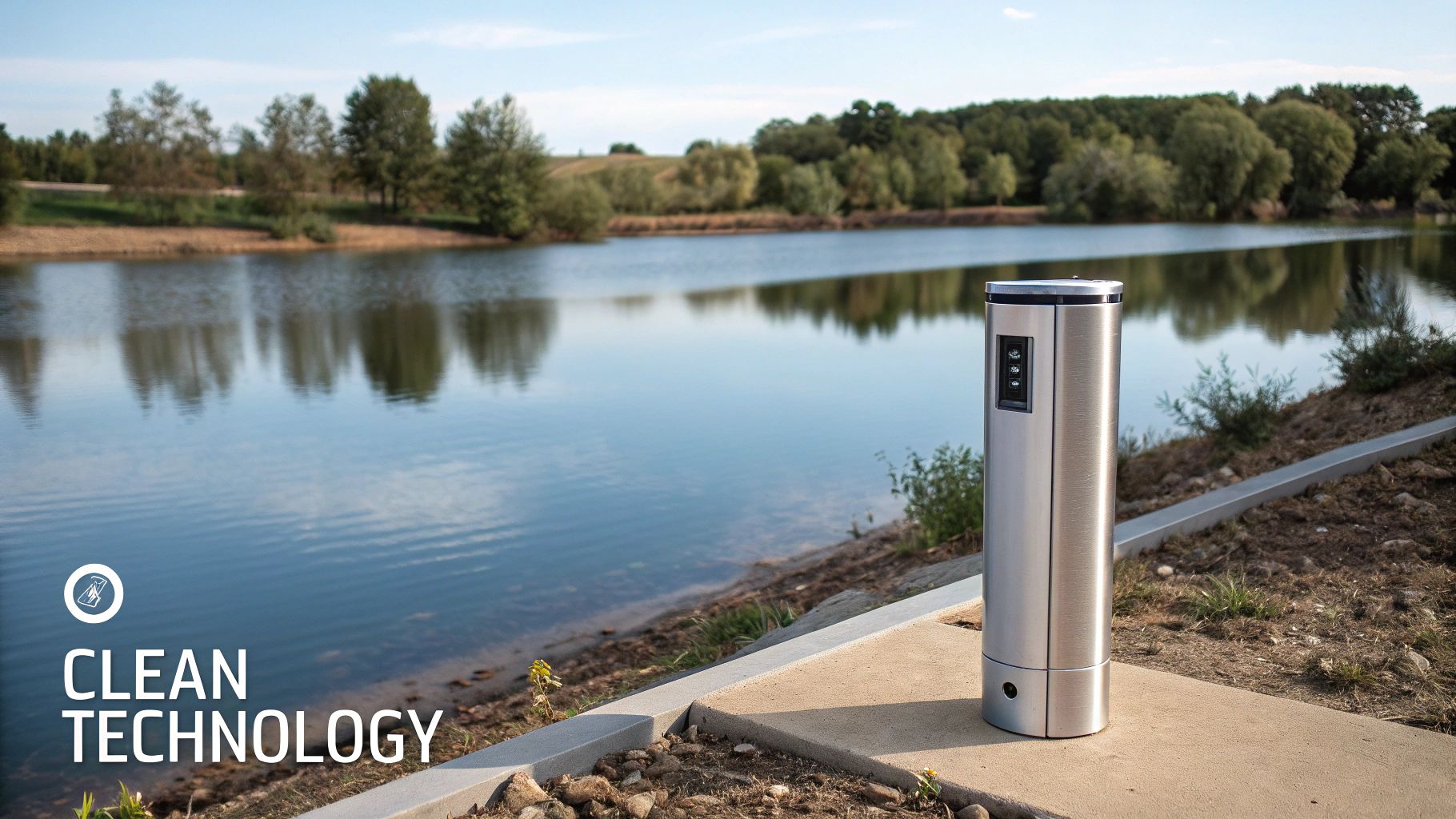The Hidden Crisis Beneath the Surface

The world's water systems are facing a growing threat. Pollution, often invisible until it's too late, is steadily impacting our water quality. Everything from everyday household products to industrial waste is contributing to this problem. This contamination has serious consequences for human health, ecosystems, and wildlife. Understanding the problem is the first step towards finding solutions.
The Main Culprits of Water Pollution
A major source of water pollution is industrial discharge. Factories and power plants frequently release wastewater filled with heavy metals, chemicals, and other harmful substances. This can contaminate rivers, lakes, and oceans, poisoning aquatic life and making the water unsafe to drink.
Agricultural runoff is another serious issue. Pesticides and fertilizers used in farming flow into our waterways. This causes eutrophication, a process that depletes oxygen and creates “dead zones.” Untreated sewage from homes and communities further degrades water quality, adding pathogens and organic matter to the mix.
The Devastating Impact On Our Planet
The consequences of water pollution are widespread. Contaminated water can cause diseases, putting both humans and animals at risk. Declining water quality harms aquatic ecosystems, disrupting the balance of life and leading to a loss of biodiversity. Economies are also affected, as industries like fishing and tourism suffer. These interconnected problems demand immediate attention.
Water pollution is a global issue made worse by growing populations, urbanization, and economic development. A staggering 42% of household wastewater isn't treated properly, negatively impacting both ecosystems and human health. This untreated wastewater includes everything from household effluent and human waste to toxic chemicals and medical waste. This often leads to pollution in densely populated areas. Learn more about the global water crisis at the United Nations water facts page. This highlights the urgent need for better wastewater management worldwide.
The Path To Cleaner Water Starts Now
Solving this crisis requires a comprehensive approach. Individual actions, community initiatives, and policy changes are all necessary. By understanding how our actions affect water quality, we can start implementing effective solutions. We can reduce water pollution and create a healthier planet for the future. Understanding the scope of the problem empowers us to take action.
Home Solutions That Make a Real Difference

Our everyday choices at home significantly affect water quality. Even small actions can contribute to – or mitigate – water pollution. This section explores practical changes you can make to lessen your household’s impact.
Rethinking Household Products
Many common household products contribute to water pollution. Conventional cleaning products, for instance, often contain harsh chemicals. These chemicals ultimately enter our water systems, harming aquatic life and disrupting delicate ecosystems. This necessitates a shift towards more sustainable options.
Switching to biodegradable, phosphate-free products offers a simple, effective way to reduce your impact. You can also consider natural cleaning solutions, such as vinegar and baking soda. These easy changes make a big difference in protecting our water resources.
To help you make informed decisions, we've compiled a comparison table outlining some eco-friendly alternatives to common household products.
This comparison table shows environmentally safer alternatives to common household products that often contribute to water pollution.
| Harmful Product | Environmental Impact | Eco-Friendly Alternative | Benefits |
|---|---|---|---|
| Conventional drain cleaner | Contains corrosive chemicals that can harm aquatic life and disrupt ecosystems. | Baking soda and vinegar, enzyme-based drain cleaners | Safe for plumbing, septic systems, and the environment. |
| Chlorine bleach | Releases harmful byproducts into waterways and can react with other substances to create toxic compounds. | Oxygen bleach, hydrogen peroxide | Effective whitening and disinfecting without the harmful chlorine. |
| Synthetic laundry detergent | Contains phosphates and other chemicals that contribute to algal blooms and oxygen depletion in water bodies. | Plant-based laundry detergent, soap nuts | Biodegradable, phosphate-free, and gentler on sensitive skin. |
| Ammonia-based cleaners | Releases ammonia gas, which can be harmful to aquatic life and contribute to air pollution. | Vinegar-based cleaners, baking soda | Effective cleaning and deodorizing without the harsh fumes. |
| Chemical-based air fresheners | Release volatile organic compounds (VOCs) that contribute to air and water pollution. | Essential oil diffusers, natural air fresheners | Freshen the air naturally without harmful chemicals. |
By switching to these eco-friendly options, you can significantly reduce your household's contribution to water pollution.
Proper Disposal of Hazardous Waste
Another crucial aspect of reducing water pollution is proper hazardous waste disposal. Items like paint, batteries, and motor oil should never be poured down the drain or tossed in the regular trash.
Instead, take these items to designated collection centers for safe disposal. This prevents harmful substances from contaminating our water and soil. Medications also pose a threat. Unused or expired medications should be returned to pharmacies or designated take-back programs.
Flushing medications can introduce pharmaceuticals into our water systems, potentially harming both human health and the environment. Proper medication disposal is a vital step. For more insights on environmentally friendly practices, you might find CLiX Fueling's blog sitemap helpful.
Addressing Leaks and Water Usage
Even small leaks can indirectly contribute to water pollution. Leaking water increases the demand on water treatment plants. This heightened demand increases their energy consumption and potential for pollution. Repairing leaks promptly conserves water and minimizes your environmental footprint.
Furthermore, reducing overall water use is essential. Simple steps like shorter showers, fixing dripping faucets, and using water-efficient appliances can significantly reduce your water consumption. This reduces the strain on our water systems. These practices contribute to water conservation and a healthier planet. Learn more about how businesses and individuals can embrace eco-friendly practices to address water pollution.
Small Changes, Big Impact
By making conscious choices at home, we can collectively make a real difference in reducing water pollution. From choosing eco-friendly products to proper hazardous waste disposal, every action counts. Embracing these habits benefits both the environment and our well-being.
Building Community-Led Water Protection Movements

Individual actions are important for protecting our water resources. However, true change happens when entire communities unite. Looking at successful water protection projects worldwide reveals how concerned citizens can become powerful advocates. These success stories show us how to turn concern into meaningful action.
From Concerned Citizens to Environmental Advocates
Ordinary people have achieved remarkable progress in safeguarding their local water. Some have established water quality monitoring programs, holding polluters responsible for their actions. This empowers communities to track pollution levels and advocate for change based on data.
Others have created watershed protection partnerships to revitalize damaged rivers and streams. These collaborative efforts bring together diverse groups, from local residents to government agencies, to work towards a common goal.
Still others have spearheaded cleanup campaigns that have breathed new life into entire ecosystems. These inspiring stories demonstrate the potential of community-driven initiatives to achieve lasting improvements in water quality.
Creating a Water Protection Project: A Step-by-Step Guide
Starting a community-based water protection project can seem overwhelming at first. But breaking it down into smaller, manageable steps makes the process much easier.
First, identify a specific water-related issue in your community. This focused approach helps direct your efforts and resources where they are most needed. For instance, you might focus on reducing plastic pollution in a local river or addressing agricultural runoff.
Next, build a diverse team of stakeholders. This includes residents, local businesses, and government officials. A diverse team brings different skills and perspectives to the table, enriching the project and increasing its chances of success.
Then, develop a clear action plan with measurable goals and realistic timelines. This plan serves as a roadmap for your project, outlining the steps needed to achieve your objectives. It also helps secure funding and attract additional support.
Finally, secure funding and resources. This can involve applying for grants, partnering with local organizations, or hosting fundraising events. Adequate resources are essential for sustaining your project over the long term.
Engaging Stakeholders and Building Momentum
Sustaining your project requires ongoing engagement and communication. Regularly update your team and the broader community on your progress. This transparency builds trust and keeps everyone involved.
Openly celebrate your achievements, but also acknowledge any challenges you encounter. Honest communication strengthens relationships and fosters a sense of shared responsibility.
Actively involve local businesses, schools, and government agencies. Partnering with these groups expands your project’s reach and creates valuable opportunities for education and outreach.
The United Nations emphasizes the critical role of international cooperation in effectively managing shared water resources. For example, internationally shared rivers and aquifers require joint management between countries. This ensures water security for all and safeguards vital environmental services. Surprisingly, only six out of 468 internationally shared aquifers have formal cooperative agreements. Learn more about this critical issue in the UNESCO water report.
By building strong community partnerships and engaging stakeholders, you can create a powerful movement for water protection. This collective effort can lead to real, sustainable improvements in water quality for everyone.
Agricultural Innovations Protecting Our Waterways

Modern farming is increasingly focused on the important connection between food production and clean water. This has spurred the adoption of new approaches that lessen environmental impact while boosting yields. These changes are transforming how we view agriculture and its role in water conservation.
Precision Farming: Targeting Efficiency and Reducing Runoff
One of the most important advances is precision farming. This method uses technologies like GPS and sensors to deliver water and fertilizer precisely where and when they're needed.
This targeted approach significantly reduces excess chemicals running off into our water systems. It also saves farmers money on inputs. Some studies have shown that precision farming can reduce chemical runoff by as much as 80%.
This precision ensures crops get necessary nutrients while minimizing environmental impact. It’s a win-win for both the farm's profitability and the health of the surrounding environment.
Buffer Zones: Nature's Water Filters
Another effective method is the use of buffer zones. These are areas of vegetation planted alongside fields, acting as natural filters.
Buffer zones intercept runoff before it contaminates waterways, absorbing excess nutrients and sediments. This straightforward technique helps prevent pollution and provides habitats for wildlife. It's a great example of how natural solutions can be part of modern farming. You can find more information at CLiX Fueling sitemap collections.
Regenerative Agriculture: Rebuilding Soil Health, Protecting Water Quality
Regenerative agriculture signifies a fundamental change in farming philosophy. This approach focuses on improving soil health using practices like no-till farming, cover cropping, and crop rotation.
Healthy soil acts as a sponge, absorbing more water and thus reducing runoff. Healthier soil also needs less fertilizer, further lessening the chance of water contamination. These combined benefits make regenerative agriculture a cornerstone of sustainable water management.
Economic and Environmental Benefits: A Win-Win for Farmers
Farms adopting these water-friendly practices are seeing both financial and environmental gains. Lower input costs and healthier soil lead to increased profits. At the same time, cleaner water benefits everyone.
Consumers can support this shift by choosing products from farms dedicated to sustainable practices. This consumer-driven change can motivate even broader use of water-friendly farming.
The Future of Farming: Sustainable and Water-Conscious
These agricultural innovations give us a look at a future where farming and water protection work together. By using technology, working with nature, and focusing on soil health, we can ensure a sustainable food supply while protecting our valuable water resources.
These practices don't just represent a change in farming techniques, but a fundamental shift toward a more sustainable future for the agricultural industry. They demonstrate a growing understanding that protecting our water is vital for the long-term health and success of agriculture.
Industrial Revolution 2.0: Cleaner Production Pathways
The manufacturing industry is often linked to water pollution. However, new industrial practices are proving that profitability and environmental responsibility can coexist. This shift involves innovative technologies and sustainable approaches to reduce water pollution. These advancements offer a brighter, cleaner future.
Closed-Loop Systems and Advanced Filtration: Rethinking Water Use
A key development in reducing industrial water pollution is the increasing use of closed-loop water systems. These systems recycle and reuse water within the facility. This significantly reduces the need for fresh water intake and minimizes wastewater discharge. Less water is taken from natural sources, and less potentially polluted wastewater is returned to the environment.
Another important innovation is advanced filtration technologies. These technologies remove even persistent contaminants from industrial wastewater, including those previously difficult to treat. This dramatically lowers the pollution entering waterways and helps protect aquatic ecosystems.
Zero-Liquid Discharge: The Ultimate Goal
Some facilities are aiming for zero-liquid discharge (ZLD). This means no wastewater is released from the facility. ZLD is a challenging but important goal, representing the highest standard of water sustainability in industrial settings. Achieving ZLD drastically reduces the environmental impact of manufacturing.
The Economic Advantages of Cleaner Production
Reducing water pollution isn’t only good for the environment; it also benefits businesses. Companies with cleaner production practices often reduce operating costs through lower water and energy consumption. Environmentally responsible companies can also attract more customers and investors, improving their brand image and market share. This creates a cycle where environmental stewardship leads to economic success.
Market Pressures and Consumer Advocacy: Driving the Shift
Several factors are driving the move towards cleaner production. Stricter environmental regulations require industries to adopt cleaner practices. Consumers are also increasingly aware of the environmental impact of the products they buy. They are actively supporting sustainable businesses. This consumer pressure is a powerful force for market change.
Supporting Water-Conscious Companies: A Guide for Consumers
Consumers are crucial in the shift to cleaner production. By carefully evaluating corporate environmental claims and supporting truly water-conscious businesses, consumers encourage companies to adopt more sustainable practices. This informed consumerism drives market demand for eco-friendly products and services, creating a more sustainable economy.
To understand the progress, let’s look at some industrial water treatment technologies:
This table presents different wastewater treatment technologies used by industries to reduce pollution.
| Technology | Pollutants Removed | Efficiency Rate | Implementation Cost | Industries Using |
|---|---|---|---|---|
| Membrane bioreactor (MBR) | Suspended solids, organic matter, pathogens | Up to 99% | Moderate to high | Municipal wastewater treatment, food processing |
| Reverse osmosis (RO) | Dissolved salts, minerals, heavy metals | Up to 99% | High | Desalination, pharmaceutical manufacturing |
| Activated carbon adsorption | Organic chemicals, pesticides, pharmaceuticals | Varies depending on the pollutant | Moderate | Drinking water treatment, industrial wastewater treatment |
| Advanced oxidation processes (AOPs) | Persistent organic pollutants (POPs), pharmaceuticals | High | Moderate to high | Industrial wastewater treatment, remediation of contaminated sites |
These technologies show the ongoing innovation in water treatment, with solutions for various pollutants and industries. They represent the growing commitment to finding effective and sustainable ways to reduce water pollution and protect our water resources.
Policy Frameworks That Actually Work
Effective governance and regulations are essential for clean water. Analyzing successful water protection policies from around the world reveals valuable insights into what truly makes them work. This includes understanding how regulations can balance environmental protection with economic growth, how enforcement changes polluter behavior, and how incentives encourage cleaner technologies.
Innovative Regulatory Frameworks: Balancing Protection and Development
Successful policies carefully consider both environmental and economic needs. For example, some regulations offer tax breaks for industries that invest in water-saving technologies. This encourages businesses to adopt sustainable practices without negatively impacting their profits. These approaches demonstrate that economic progress and environmental stewardship can work together.
Enforcement Mechanisms: Changing Polluter Behavior
Strong enforcement is a cornerstone of effective water protection. Penalties for polluting must be significant enough to outweigh the cost of compliance. This helps discourage illegal dumping and motivates industries to invest in proper waste treatment. Regular inspections and transparent reporting are vital for holding polluters accountable and maintaining the integrity of the regulations.
Economic Incentives: Accelerating Adoption of Cleaner Tech
Financial incentives can play a crucial role in accelerating the adoption of sustainable practices. Grants and subsidies for environmentally friendly technology make it more affordable for businesses to implement. For instance, a government might provide financial support for the installation of wastewater treatment systems. This type of support encourages businesses to make environmentally responsible investments.
Integrated Water Resource Management: A Holistic Approach
Effective water protection needs a holistic approach. Integrated water resource management (IWRM) considers every aspect of the water cycle. It links land use, water allocation, and pollution control to achieve sustainable water use. This comprehensive approach helps ensure the long-term health of our water resources. For a deeper dive into this topic, check out this guide: How to Master Integrated Water Management Practices.
Citizen Engagement: Influencing Policy
Engaged citizens have a vital role in shaping water policy. Successful water protection movements often involve community groups advocating for stronger regulations. By working together, citizens can influence policy decisions and hold their elected officials accountable for protecting water resources. This collaborative approach is essential for driving meaningful change.
Successful Policy Examples: Learning From Others
Learning from successful policies implemented around the world can help inform the development of effective local solutions. The city of Everett, Washington, offers a great example of a comprehensive approach to industrial wastewater treatment. Their Water Pollution Control Facility permit includes detailed requirements for businesses, increased monitoring for emerging pollutants, and strategic discharge management to minimize impact on sensitive ecosystems like the Snohomish River. These proactive measures demonstrate a commitment to protecting local water resources.
Effective water protection policies require a combination of well-designed regulations, effective enforcement, and incentives for sustainable practices. Citizen involvement and a holistic approach to water resource management are also crucial for achieving significant and lasting improvements in water quality.
Protect our waterways and improve your boating experience with CLiX Fueling Solutions. Our innovative, spill-free fueling system helps prevent harmful fuel leaks into marine ecosystems. Learn more and order yours today.











